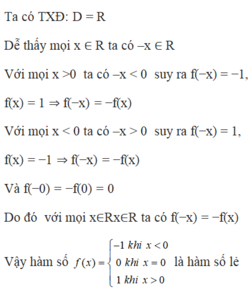Xét tính chẵn lẻ của hàm số: f(x) = \(\hept{\begin{cases}x^3+1;x\le-1\\0;-1< x< 1\\x^3-1;x\ge1\end{cases}}\)
Hãy nhập câu hỏi của bạn vào đây, nếu là tài khoản VIP, bạn sẽ được ưu tiên trả lời.


Bài 1:
\(f\left(-x\right)=\left|\left(-x\right)^3+x\right|=\left|-x^3+x\right|=\left|-\left(x^3-x\right)\right|=\left|x^3-x\right|=f\left(x\right)\)
Vậy hàm số chẵn
Bài 2:
\(f\left(4\right)=4-3=1\\ f\left(-1\right)=2.1+1-3=0\\ b,\text{Thay }x=4;y=1\Leftrightarrow4-3=1\left(\text{đúng}\right)\\ \Leftrightarrow A\left(4;1\right)\in\left(C\right)\\ \text{Thay }x=-1;y=-4\Leftrightarrow2\left(-1\right)^2+1-3=-4\left(\text{vô lí}\right)\\ \Leftrightarrow B\left(-1;-4\right)\notin\left(C\right)\)

Tập xác định của hàm số f(x)và g(x) đều là ℝ .
Với x ∈ ℝ thì - x ∈ ℝ và ta có: f - x = - - x = - x = f x ;
g - x = - x + 1 - - x - 1 = x - 1 - x + 1 = - g x .
Vậy f(x)là hàm số chẵn, g(x) là hàm số lẻ. Đáp án là D.


Với giá trị \(x_0\) bất kì:
- Nếu \(-1< x_0< 1\Rightarrow-1< -x_0< 1\)
\(\Rightarrow f\left(-x_0\right)=0=-0=-f\left(x_0\right)\)
- Nếu \(x_0\le-1\Rightarrow f\left(x_0\right)=x_0^3+1\)
\(x_0\le-1\Rightarrow-x_0\ge1\Rightarrow f\left(-x_0\right)=\left(-x_0\right)^3-1=-\left(x^3_0+1\right)=-f\left(x_0\right)\)
- Nếu \(x_0\ge1\Rightarrow-x_0\le-1\)
\(f\left(x_0\right)=x_0^3-1\)
\(f\left(-x_0\right)=\left(-x_0\right)^3+1=-\left(x_0^3-1\right)=-f\left(x_0\right)\)
Vậy \(f\left(-x_0\right)=-f\left(x_0\right)\) \(\forall x_0\in R\Rightarrow f\left(x\right)\) là hàm lẻ